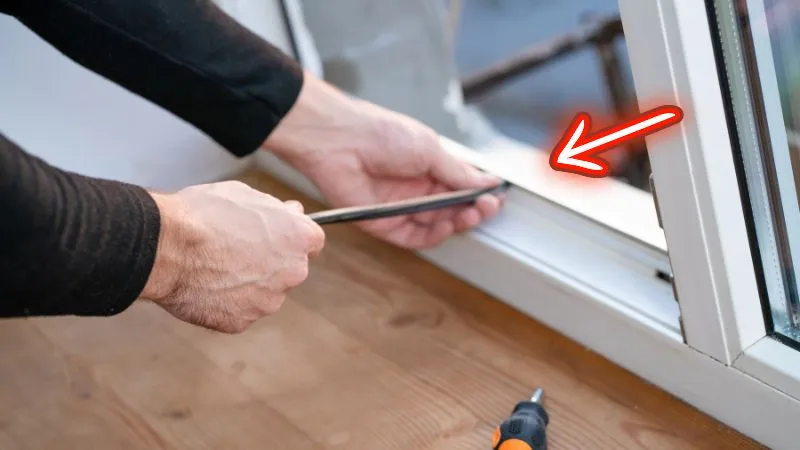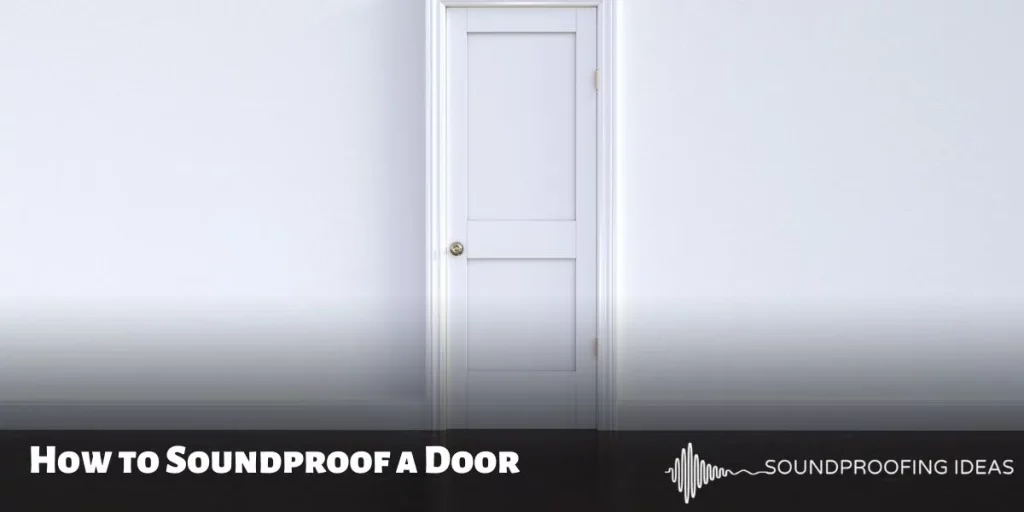In this article, I’ll discuss the different methods and materials you can use to soundproof a door.
I’ll also provide a step-by-step guide on how to soundproof a door yourself, as well as tips on how to choose the best method for your specific needs and budget.
There are several different methods you can use to soundproof a door, each with its own set of benefits and drawbacks.
Some methods are more effective at blocking sound, while others are easier to install or more budget-friendly.
In this section, we will discuss the different methods you can use to soundproof a door and the pros and cons of each.
Contents
- Method 1: Install Weatherstripping
- Method 2: Install a Soundproofing Door Sweep or Seal
- Method 3: Install a Door Gasket
- Method 4: Install Soundproofing Panels or Tiles
- Method 5: Install Soundproofing Cloth or Mats
- Method 6: Add Mass Loaded Vinyl
- Method 7: Install a Soundproofing Door Kit
- Method 8: Install a Soundproof Door
- Method 9: Use Soundproofing Paint
Method 1: Install Weatherstripping

One of the easiest and most affordable ways to soundproof a door is to install weatherstripping.
Weatherstripping is a strip of material used to seal gaps around the edges of a door to keep out drafts and prevent heat loss.
It can also be used to block sound from passing through the gap between the door and the frame.
There are several different types of weatherstripping you can use to soundproof a door, including:
- Felt stripping: Felt stripping is made of compressed fibers and is often used on the bottom of a door to block drafts and sound. It is inexpensive and easy to install, but it may not be as effective at blocking sound as other types of weatherstripping.
- Foam tape: Foam tape is a type of weatherstripping made of self-adhesive foam. It is easy to install and provides a good seal, but it may not last as long as other types of weatherstripping.
- V-strip: V-strip is a type of weatherstripping that is shaped like a V. It is made of flexible metal or plastic and is used to seal gaps around the edges of a door. It is more durable than foam tape and provides a good seal, but it may be more difficult to install.
To install weatherstripping on a door, you will need the following tools & materials
- Weatherstripping of your choice
- Measuring tape
- Pencil
- Scissors (if using foam tape or felt stripping)
- Staple gun (if using felt stripping)
How to install weatherstripping on a door?
- Measure the gap around the edges of the door and cut the weatherstripping to fit. If using foam tape or felt stripping, be sure to leave enough excess to overlap the edges of the door and frame.
- Peel off the backing on the weatherstripping and press it into place around the edges of the door. If using foam tape or felt stripping, use a staple gun to secure it in place.
- Test the door to make sure it is properly sealed and that the weatherstripping is blocking the sound. If you can still hear noise coming through the door, you may need to add additional strips of weatherstripping or try a different method.
Pros
- Inexpensive
- Easy to install
- Can be easily removed without damaging the door or frame
Cons
- It may not be as effective at blocking sound as other methods
- May not last as long as other types of weatherstripping
Method 2: Install a Soundproofing Door Sweep or Seal
A soundproofing door sweep or seal is a specialized strip of material that is designed specifically to block sound from passing through the gap between a door and the floor or the edges of the door and the frame.
These materials are typically made of dense, flexible foam or fabric and are easy to install.
They can be an effective way to block sound from entering or exiting a room through a door.
To install a soundproofing door sweep or seal, you will need the following tools & materials
- A soundproofing door sweep or seal
- Screwdriver
- Screws
How to install a soundproofing door sweep or seal?
- Measure the gap around the edges of the door or between the door and the floor and cut the soundproofing door sweep or seal to fit.
- Hold the soundproofing door sweep or seal in place against the door and mark the locations of the holes.
- Pre-drill holes in the door at the marked locations.
- Attach the soundproofing door sweep or seal to the door using the screws provided.
- Test the door to ensure it is properly sealed and that the soundproofing door sweep or seal is effectively blocking sound. If you can still hear noise coming through the door, you may need to add additional strips of soundproofing material or try a different method.
Pros
- Easy to install
- Can be an effective way to block sound from entering or exiting a room through a door
- Can be easily removed without damaging the door or frame
Cons
- It may not be as effective at blocking sound as other methods
- May not last as long as other types of soundproofing materials
Method 3: Install a Door Gasket

A door gasket is a strip of material that is designed to seal off the gaps around a door to block sound from entering or exiting a room.
Door gaskets are typically made of a flexible foam or rubber material and are easy to install.
They can be an effective way to block sound from coming through the gaps around a door.
To install a door gasket, you will need the following tools & materials
- Door gasket
- Screwdriver (optional)
- Measuring tape
- Utility knife (optional)
How to install a door gasket?
- Measure the door frame: Use a measuring tape to measure the width and height of the door frame. Make note of any irregularities or unevenness in the frame.
- Cut the door gasket to size: Using the measurements you took, cut the door gasket to the appropriate length. If necessary, use a utility knife to trim the gasket to size.
- Install the door gasket: Peel the backing off the door gasket and attach it to the door frame. Make sure the gasket is pressed firmly against the frame to create a good seal. Use a screwdriver to attach the gasket if necessary.
- Test the door gasket: Once the gasket is installed, close the door and listen for any noise coming through the gap between the door and the door frame. If you can hear noise, you may need to adjust the gasket or add additional soundproofing materials to the door.
Pros
- Easy to install
- Inexpensive
- Effective at blocking noise coming through the gaps around a door
Cons
- Limited effectiveness
Method 4: Install Soundproofing Panels or Tiles
Soundproofing panels or tiles are pre-made, self-adhesive panels or tiles that are designed to block sound from passing through a door.
These materials are typically made of dense, flexible foam or fabric and are easy to install.
They can be cut to fit any size or shape and are an effective way to block sound.
To install soundproofing panels or tiles, you will need the following tools & materials
- Soundproofing panels or tiles
- Scissors
How to install soundproofing panels or tiles?
- Measure the door or area you want to soundproof and cut the soundproofing panels or tiles to fit.
- Peel off the backing on the adhesive side of the soundproofing panels or tiles and press them into place on the door or wall.
- Test the door to ensure the soundproofing panels or tiles are effectively blocking sound. If you can still hear noise coming through, you may need to add additional layers of soundproofing panels or tiles or try a different method.
Pros
- Easy to install
- Can be easily removed without damaging the door or wall
- Can be cut to fit any size or shape
Cons
- It may not be as effective at blocking sound as other methods
- May not last as long as other types of soundproofing materials
Method 5: Install Soundproofing Cloth or Mats
Another option for soundproofing a door is to install soundproofing cloth or mats.
These materials are typically made of a dense, flexible fabric or foam and are designed to block sound from passing through a door or wall.
They can be easily cut to size and installed using adhesive or staples.
To install soundproofing cloth or mats, you will need the following tools & materials
- Soundproofing cloth or mats
- Scissors
- Adhesive or staples
How to install soundproofing cloth or mats?
- Measure the door or area you want to soundproof and cut the soundproofing cloth or mats to fit.
- Peel off the backing on the adhesive side of the soundproofing material and press it into place on the door or wall. Alternatively, use staples to attach the soundproofing material to the door or wall.
- Test the door or wall to ensure the soundproofing material is effectively blocking sound. If you can still hear noise coming through, you may need to add additional layers of soundproofing material or try a different method.
Pros
- Easy to install
- Can be easily removed without damaging the door or wall
- Can be cut to fit any size or shape
Cons
- It may not be as effective at blocking sound as other methods
- May not last as long as other types of soundproofing materials
Method 6: Add Mass Loaded Vinyl
Mass-loaded vinyl (MLV) is a dense, heavy material that is designed specifically to block sound.
MLV can be used in a variety of soundproofing applications, including blocking sound from entering or exiting a room through a door.
To use MLV for soundproofing a door, you will need to install it on the surface of the door or in the gaps around the door.
To add mass-loaded vinyl to a door, you will need the following tools & materials
- Mass loaded vinyl
- Adhesive or tape (optional)
- Screwdriver (optional)
- Screws (optional)
How to add mass-loaded vinyl to a door?
- Measure the door and cut the mass-loaded vinyl to fit.
- Attach the mass-loaded vinyl to the door using adhesive or tape, or by screwing it into place.
- Test the door to make sure it is properly sealed and that the mass-loaded vinyl is blocking sound effectively. If you can still hear noise coming through the door, you may need to add additional strips of mass-loaded vinyl or try a different method.
Pros
- Can be an effective way to block sound from entering or exiting a room through a door
- Can be easily removed without damaging the door or frame
Cons
- May be more expensive than other types of soundproofing materials
- May be difficult to install depending on the size and shape of the door
- May not be suitable for all types of doors
Method 7: Install a Soundproofing Door Kit
A soundproofing door kit is a pre-packaged set of materials specifically designed to block sound from passing through a door.
These kits typically include weatherstripping, door sweeps, and door seals, as well as additional materials such as door gaskets and door sweeps.
Soundproofing door kits are more expensive than individual soundproofing materials, but they can be an effective way to block sound from passing through a door.
To install a soundproofing door kit, you will need the following tools and materials
- Soundproofing door kit
- Screwdriver
- Screws
How to install a soundproofing door kit?
- Follow the instructions provided with the kit to install the various components, such as weatherstripping, door sweeps, and door seals.
- Test the door to make sure it is properly sealed and that the soundproofing materials are blocking sound. If you can still hear noise coming through the door, you may need to add additional strips of weatherstripping or try a different method.
Pros
- Can be more effective at blocking sound than individual materials
- Comes with all the materials needed for a complete soundproofing solution
Cons
- More expensive than individual materials
- May not be as customizable as using individual materials
Method 8: Install a Soundproof Door
If you want a more permanent and effective solution for soundproofing a door, you may want to consider installing a soundproof door. Soundproof doors are designed specifically to block sound from passing through them and are typically made of thick, heavy materials such as solid wood or metal. They may also have additional soundproofing features such as seals and gaskets to further block sound.
To install a soundproof door, you will need the following tools and materials?
- Soundproof door
- Screwdriver
- Screws
- Door hinges
- Door handle and lock set
How to install a soundproof door?
- Remove the existing door and any hardware such as hinges and handles.
- Measure the opening for the new door to ensure that it will fit properly.
- Install the hinges on the door according to the manufacturer’s instructions.
- Hold the door up to the opening and mark the locations of the hinges on the door frame.
- Pre-drill holes in the door frame at the marked locations.
- Attach the hinges to the door frame using the screws provided.
- Install the door handle and lock set according to the manufacturer’s instructions.
- Test the door to make sure it is properly sealed and that it is blocking sound.
Pros
- Highly effective at blocking sound
- Permanent solution
Cons
- Expensive
- Requires more time and effort to install
Method 9: Use Soundproofing Paint
Soundproofing paint is a specialized type of paint that is designed to block sound from passing through walls, ceilings, and floors. It is typically made of dense, flexible foam or fabric and is applied like regular paint. It can be an effective way to block sound in a room, but it is important to note that it may not be as effective at blocking sound as other methods, such as installing soundproofing panels or tiles.
To use soundproofing paint, you will need the following tools & materials
- Soundproofing paint
- Paint roller or brush
- Drop cloth
- Masking tape
How to use soundproofing paint?
- Prep the area you want to paint by covering floors and furniture with a drop cloth and taping off any areas you do not want to paint.
- Stir the soundproofing paint thoroughly to ensure it is well-mixed.
- Apply the soundproofing paint to the door or wall using a paint roller or brush, following the manufacturer’s instructions. Be sure to apply multiple coats if necessary.
- Allow the paint to dry completely according to the manufacturer’s instructions.
- Test the door or wall to ensure the soundproofing paint is effectively blocking sound. If you can still hear noise coming through, you may need to add additional layers of soundproofing paint or try a different method.
Pros
- Easy to use
- Can be an effective way to block sound in a room
- Can be easily removed without damaging the door or wall
Cons
- It may not be as effective at blocking sound as other methods
- May not last as long as other types of soundproofing materials
Soundproofing a door is a useful project for those who want to reduce the amount of noise that enters or exits a room.
There are several different methods and materials you can use to soundproof a door, each with its own set of benefits and drawbacks.
Whether you choose to install weatherstripping, a door sweep, a door seal, a soundproofing door kit, or a soundproof door, it is important to consider your specific needs and budget when deciding on the best method for your situation.
By following the steps and tips outlined in this article, you can effectively soundproof your door and create a more peaceful and quiet living or working environment.
It is also important to note that soundproofing a door is just one aspect of soundproofing a room. To achieve maximum sound reduction, it may be necessary to address other areas such as the walls, windows, and floors.
Overall, soundproofing a door is a relatively easy and effective way to reduce the amount of noise that enters or exits a room.
By choosing the right method and materials for your specific needs and budget, you can create a more peaceful and quiet living or working environment.

